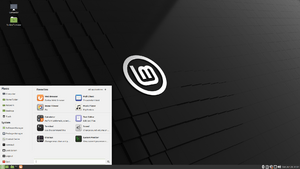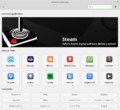Linux Mint facts for kids
 |
|

Linux Mint 20 ("Ulyana") running MATE 1.24 (top) and Cinnamon 4.6.6 (bottom)
|
|
| Company / developer | Clement Lefebvre, Jamie Boo Birse, Kendall Weaver, and community |
|---|---|
| OS family | Unix-like, based on Ubuntu, optionally based on Debian (LMDE) Linux Mint Xfce Linux Mint KDE |
| Working state | Active |
| Source model | Open source |
| Initial release | 27 August 2006 |
| Latest stable release | Linux Mint 20 ("Ulyana") / June 27, 2020 |
| Available language(s) | Multilingual |
| Update method | APT (+ mintUpdate, Synaptic) |
| Package manager | dpkg |
| Supported platforms | i486, x86-64 |
| Kernel type | Monolithic (Linux) |
| Default user interface | 1.0-8: KDE 9: GNOME 2 12: GNOME 3 with MGSE 13-17: Cinnamon/MATE/Xfce/KDE |
| License | Mainly GPL and other free software licenses, minor additions of proprietary |
Linux Mint is a Linux distribution for desktop computers based on and compatible with Debian or Ubuntu.
While at the core Linux Mint is mostly based on Ubuntu, the design of the desktop and User interface are very different. These differences include a very unique desktop theme, a custom Linux Mint menu and the MintTools, a collection of system tools designed to make managing the computer easier for users.
Releases
Originally, Linux Mint did not follow a predictable release cycle. The project first defined the goals for the next release, and when all the goals are achieved a beta is released and a date is announced for the stable release. Recently however, it has been decided that Linux Mint will be with the 6 month Ubuntu release cycle.
| Colour | Meaning |
|---|---|
| Red | Old release; not supported |
| Yellow | Old release; still supported |
| Green | Current release |
| Purple | Test release |
| Blue | Future release |
| Version | Code name | Release date | Support status |
|---|---|---|---|
| 1.0 beta | Ada | 2006-08-27 | Obsolete since April 2008. Unstable. |
| 2.0 | Barbara | 2006-11-13 | Obsolete since April 2008. |
| 2.1 | Bea | 2006-12-20 | Obsolete since April 2008. |
| 2.2 | Bianca | 2007-02-20 | Obsolete since April 2008. |
| 3.0 | Cassandra | 2007-05-30 | Obsolete since October 2008. |
| 3.1 | Celena | 2007-09-24 | Obsolete since October 2008. |
| 4.0 | Daryna | 2007-10-15 | Obsolete since April 2009. |
| 5 LTS | Elyssa | 2008-06-08 | Long-term support release (LTS), obsolete since April 2011. |
| 6 | Felicia | 2008-12-15 | Obsolete since April 2010. |
| 7 | Gloria | 2009-05-26 | Obsolete since October 2010. |
| 8 | Helena | 2009-11-29 | Obsolete since April 2011. |
| 9 LTS | Isadora | 2010-05-18 | Long-term support release (LTS), obsolete since April 2013. |
| 10 | Julia | 2010-11-12 | Obsolete since April 2012. |
| 11 | Katya | 2011-05-26 | Obsolete since October 2012. |
| 12 | Lisa | 2011-11-26 | Obsolete since April 2013. |
| 13 LTS | Maya | 2012-05-23 | Long-term support release (LTS), obsolete since April 2017. |
| 14 | Nadia | 2012-11-20 | Obsolete since May 2014. |
| 15 | Olivia | 2013-05-29 | Obsolete since January 2014. |
| 16 | Petra | 2013-11-30 | Obsolete since July 2014. |
| 17 LTS | Qiana | 2014-05-31
v2 "respin" 2014-06-29 |
Long-term support release (LTS), obsolete since April 2019. |
| 17.1 LTS | Rebecca | 2014-11-29 | First of 17.x series of releases, Long-term support release (LTS), obsolete since April 2019. |
| 17.2 LTS | Rafaela | end of May 2015 | Second of 17.x series of releases, Long-term support release (LTS), obsolete since April 2019. |
| 17.3 LTS | Rosa | 2015-12-04 | Third of 17.x series of releases, Long-term support release (LTS), obsolete since April 2019. |
| 18 LTS | Sarah | 2016-06-30 | Long-term support release (LTS), supported until April 2021. |
| 19 LTS | Tara | 2018-06-29 | Long-term support release (LTS), supported until 2023. |
| 19.1 LTS | Tessa | 2018-12-19 | Long-term support release (LTS), supported until 2023. |
| 19.2 LTS | Tina | 2019-08-02 | Long-term support release (LTS), supported until 2023. |
| 19.3 LTS | Tricia | 2019-12-18 | Long-term support release (LTS), supported until 2023. |
| 20 LTS | Ulyana | 2020-06-27 | Long-term support release (LTS), supported until 2025. |
Comparison with Ubuntu
Linux Mint is based on Ubuntu and both distributions have a lot in common. Both distributions use the same software repositories. For instance, release 2.2 (“Bianca”) uses the package pools of Ubuntu “Edgy Eft” (6.10). Most packages are the same on both distributions and the two systems behave almost identically.
Most differences are on the desktop. Ubuntu and Linux Mint both focus on usability, but Linux Mint offers a different user experience, and it includes a number of applications that are not available in Ubuntu (see aforementioned Mint Tools).
Many popular multimedia codecs are installed by default in Linux Mint. Ubuntu, and many other gratis GNU/Linux distributions, do not distribute these codecs with the initial install media due to patent encumberment issues.
Ubuntu has a vastly larger support community than Linux Mint. However, the majority of Ubuntu help and advice is also applicable to Linux Mint. Ubuntu supports more languages from the Live CD, and comes with better localization.
Related pages
Images for kids
-
Linux Mint 10 (Julia) with KDE 4
-
Linux Mint 12 (Lisa) with Xfce
-
Linux Mint 12 (Lisa) with MATE, showing Caja and the MintMenu
-
Linux Mint 13 (Maya) with the MATE desktop environment
-
Linux Mint 14 (Nadia) with KDE
See also
 In Spanish: Linux Mint para niños
In Spanish: Linux Mint para niños
































